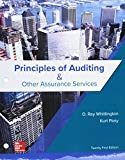
GEN COMBO LL PRINCIPLES OF AUDITING & OTHER ASSURANCE SERVICES; CONNECT AC
21st Edition
ISBN: 9781260427202
Author: Ray Whittington, Kurt Pany
Publisher: McGraw-Hill Education
expand_more
expand_more
format_list_bulleted
Question
Chapter 5, Problem 48EOQ
To determine
Identify the appropriate answer related to developing an expectation for analytical procedures.
Expert Solution & Answer
Want to see the full answer?
Check out a sample textbook solution
Students have asked these similar questions
what cost per unit would be used for product costing under variable costing ???
I need the correct answer to this general accounting problem using the standard accounting approach.
chose best answer
Chapter 5 Solutions
GEN COMBO LL PRINCIPLES OF AUDITING & OTHER ASSURANCE SERVICES; CONNECT AC
Ch. 5 - Prob. 1RQCh. 5 - Prob. 2RQCh. 5 - Prob. 3RQCh. 5 - Distinguish among routine, nonroutine, and...Ch. 5 - Prob. 5RQCh. 5 - Prob. 6RQCh. 5 - Prob. 7RQCh. 5 - As part of the verification of accounts receivable...Ch. 5 - Prob. 9RQCh. 5 - When in the course of an audit might the auditors...
Ch. 5 - Prob. 11RQCh. 5 - Prob. 12RQCh. 5 - Prob. 13RQCh. 5 - Prob. 14RQCh. 5 - Prob. 15RQCh. 5 - Prob. 16RQCh. 5 - Prob. 17RQCh. 5 - Prob. 18RQCh. 5 - Prob. 19RQCh. 5 - What disclosures should be made in the financial...Ch. 5 - Prob. 21RQCh. 5 - Prob. 22RQCh. 5 - Prob. 23RQCh. 5 - Prob. 24RQCh. 5 - Prob. 25RQCh. 5 - Prob. 26RQCh. 5 - Prob. 27RQCh. 5 - Prob. 28RQCh. 5 - Prob. 29RQCh. 5 - Prob. 30RQCh. 5 - Prob. 31RQCh. 5 - I have finished my testing of footings of the cash...Ch. 5 - Prob. 33RQCh. 5 - Prob. 34RQCh. 5 - Financial statements contain a number of...Ch. 5 - Prob. 36QRACh. 5 - In an audit of financial statements, the auditors...Ch. 5 - Prob. 38QRACh. 5 - Prob. 39QRACh. 5 - Prob. 40QRACh. 5 - Prob. 41QRACh. 5 - Prob. 42QRACh. 5 - Prob. 43QRACh. 5 - Prob. 44QRACh. 5 - Prob. 45AOQCh. 5 - Prob. 45BOQCh. 5 - Prob. 45COQCh. 5 - Prob. 45DOQCh. 5 - Prob. 45EOQCh. 5 - Prob. 45FOQCh. 5 - Prob. 45GOQCh. 5 - Prob. 45HOQCh. 5 - Prob. 45IOQCh. 5 - Prob. 45JOQCh. 5 - Prob. 45KOQCh. 5 - A difference of opinion concerning accounting and...Ch. 5 - Prob. 46OQCh. 5 - Prob. 47OQCh. 5 - Prob. 48AOQCh. 5 - Prob. 48BOQCh. 5 - Prob. 48COQCh. 5 - The cost of analytical procedures in terms of time...Ch. 5 - Prob. 48EOQCh. 5 - Prob. 49OQCh. 5 - Prob. 50PCh. 5 - Prob. 51PCh. 5 - Prob. 52PCh. 5 - Prob. 53PCh. 5 - Prob. 54PCh. 5 - Prob. 55PCh. 5 - Prob. 56P
Knowledge Booster
Similar questions
arrow_back_ios
SEE MORE QUESTIONS
arrow_forward_ios
Recommended textbooks for you
 Auditing: A Risk Based-Approach (MindTap Course L...AccountingISBN:9781337619455Author:Karla M Johnstone, Audrey A. Gramling, Larry E. RittenbergPublisher:Cengage Learning
Auditing: A Risk Based-Approach (MindTap Course L...AccountingISBN:9781337619455Author:Karla M Johnstone, Audrey A. Gramling, Larry E. RittenbergPublisher:Cengage Learning Auditing: A Risk Based-Approach to Conducting a Q...AccountingISBN:9781305080577Author:Karla M Johnstone, Audrey A. Gramling, Larry E. RittenbergPublisher:South-Western College Pub
Auditing: A Risk Based-Approach to Conducting a Q...AccountingISBN:9781305080577Author:Karla M Johnstone, Audrey A. Gramling, Larry E. RittenbergPublisher:South-Western College Pub

Auditing: A Risk Based-Approach (MindTap Course L...
Accounting
ISBN:9781337619455
Author:Karla M Johnstone, Audrey A. Gramling, Larry E. Rittenberg
Publisher:Cengage Learning

Auditing: A Risk Based-Approach to Conducting a Q...
Accounting
ISBN:9781305080577
Author:Karla M Johnstone, Audrey A. Gramling, Larry E. Rittenberg
Publisher:South-Western College Pub